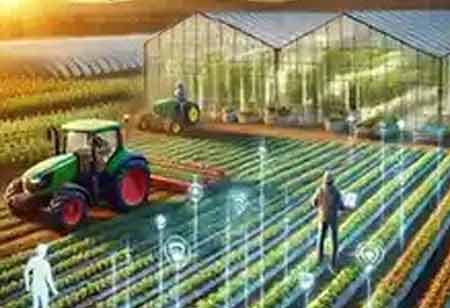Thank you for Subscribing to Agri Business Review Weekly Brief
Harvesting Opportunities in the Farmland Investment Landscape

By
Agri Business Review | Wednesday, April 02, 2025
Stay ahead of the industry with exclusive feature stories on the top companies, expert insights and the latest news delivered straight to your inbox. Subscribe today.
The farmland investment industry has long been seen as a key component of creating sustainable wealth, particularly when interest in green investment and sustainable food systems is on the rise. Over recent years, the industry has evolved significantly, adapting to both technological advances and changing global demands. As a result, companies involved in this sector are facing a unique blend of challenges and opportunities. The key to success is their ability to innovate and navigate challenges while capitalizing on the growing trends of sustainability, technological integration, and changing agricultural policies.
Shaping the Future of Sustainability and Tech in Farming
One of the most significant trends in farmland investment is the shift toward sustainability. Investors and farmers alike are increasingly recognizing the economic potential of regenerative farming practices, which prioritize the long-term health of the land. The goals of regenerative agriculture are to reduce chemical inputs, increase biodiversity, and improve soil health. These practices not only support environmental sustainability but also contribute to improved crop yields and profitability. Many farmland investors are embracing this shift by funding regenerative agriculture initiatives, acknowledging that a healthier ecosystem can lead to higher returns over time.
Simultaneously, technology is playing a critical role in transforming farmland investment strategies. The integration of AI, data analytics, and autonomous machinery has allowed investors to gain deeper insights into crop management, weather patterns, and land productivity. AI-based platforms are now offering real-time information to allow farmers to make data-driven decisions on irrigation, fertilization, and pest management, leading to maximized resource utilization and reduced wastage. These technology tools also offer investors clearer and more precise metrics, making investment in farmland more accessible and efficient than ever.
Advancements in Controlled Environment Agriculture (CEA), such as vertical farming and high-tech greenhouse systems, are also gaining traction. These innovations allow for year-round production, irrespective of climate conditions, and enable farmers to produce high-value crops in urban environments. The CEA trend is addressing the growing demand for local food production, reducing transportation costs, and lowering the carbon footprint associated with food delivery. For investors, this offers a highly scalable solution that aligns with both sustainability goals and profitability.
Navigating Challenges and Embracing Innovative Solutions in Farmland Investment
While the farmland investment industry presents many opportunities, it is also fraught with challenges. Economic volatility remains one of the most significant hurdles for investors. The agricultural sector is particularly sensitive to global trade shifts, price fluctuations, and environmental changes. Unpredictable weather patterns, such as droughts or floods, can affect crop output, for example, and these outside variables cause uncertainty for investors.
Furthermore, regulatory changes and evolving government policies are adding a layer of complexity to the sector. A prime example of this is the increasing legislative focus on foreign ownership of agricultural land. Some regions have introduced laws that restrict foreign investors from purchasing farmland, citing concerns about national security and economic sovereignty. These policy shifts are creating uncertainty for international investors who have traditionally sought opportunities in the agricultural sector.
To meet growing challenges, firms are expanding their portfolios with "impact investing" practices that balance both financial returns and beneficial social or environmental impacts. These investments concentrate on initiatives reducing water consumption, preventing soil loss, or investing in rural development. This method reduces environmental and policy risks and draws sustainability capital. In addition, the rising price of agricultural land, driven by institutional investors, has become more difficult for small players to match. In response, firms are looking into other models, such as land leasing or joint ventures with local farmers, lowering initial capital and minimizing the volatility of land prices.
Opportunities and Advancements in the Sector
The farmland investment sector is filled with opportunities. The increased demand for sustainable and locally sourced food presents an exciting growth trajectory for investors. Regenerative agriculture and CEA technologies are not only environmentally beneficial but also financially promising. Companies that can effectively integrate these practices into their investment strategies will likely see a positive impact on their bottom lines, particularly as consumer demand for sustainable food products continues to rise.
One of the most significant opportunities in the sector lies in carbon credit markets. As global awareness of climate change grows, governments and corporations are increasingly looking for ways to offset their carbon emissions. Farmland, particularly land that adopts regenerative practices, plays a pivotal role in sequestering carbon. Investors can tap into this opportunity by supporting projects that are certified for carbon credits, allowing them to earn additional revenue while contributing to environmental sustainability. This opens up new revenue streams and aligns farmland investments with broader global sustainability goals.
Technological advancements in farming equipment and precision agriculture are enabling higher productivity on smaller plots of land. Drones, autonomous tractors, and AI-powered analytics are revolutionizing how farmers approach crop management, significantly reducing labor costs while improving yields. Investors who integrate these technologies into their portfolios can expect more efficient and profitable operations, as well as a reduction in operational risks tied to labor shortages and inefficiencies.





